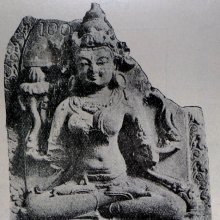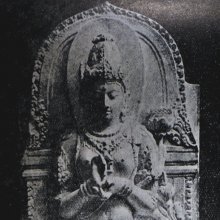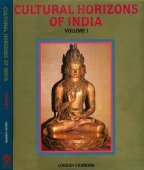Java: 28 definitions
Introduction:
Java means something in Buddhism, Pali, Hinduism, Sanskrit, Jainism, Prakrit, the history of ancient India, Marathi, biology. If you want to know the exact meaning, history, etymology or English translation of this term then check out the descriptions on this page. Add your comment or reference to a book if you want to contribute to this summary article.
Images (photo gallery)
(+11 more images available)
In Hinduism
Purana and Itihasa (epic history)
Source: archive.org: Puranic EncyclopediaJava (जव).—A warrior of Subrahmaṇya. (Mahābhārata Śalya Parva, Chapter 45, Stanza 75)
Source: archive.org: Shiva Purana - English Translation1) Java (जव) refers to “barley grains” which is used in the worship of Śiva, according to the Śivapurāṇa 2.1.13:—“[...] then the Ācamana shall be offered and cloth dedicated. Gingelly seeds, barley grains (java), wheat, green gram or black gram shall then be offered to Śiva with various mantras. Then flowers shall be offered to the five-faced noble soul. Lotuses, rose, Śaṅkha, and Kuśa flowers, Dhattūras, Mandāras grown in a wooden vessel, holy basil leaves or Bilva leaves shall be offered to each of the faces in accordance with the previous meditation or according to one’s wish. By all means Śiva favourably disposed to His devotees shall be worshipped with great devotion. If other flowers are not available, Bilva leaves shall be used exclusively in the worship of Śiva”.
2) Java (जव) refers of the “speedy flight” (of a bird), according to the Śivapurāṇa 2.5.16 (“The battle of the gods”).—Accordingly, after Viṣṇu spoke to Lakṣmī: “[...] Then the Daityas afflicted by the gusts of wind set in motion by the wings in the speedy flight (java-pakṣavāta) of the younger brother of Aruṇa (i.e Garuḍa) were blown here and there like the clouds in the sky tossed about in a stormy whirlwind. Then on seeing the Asuras afflicted by the gusts of wind, Jalandhara rushed against Viṣṇu shouting out cries of bravery angrily. [...]”.

The Purana (पुराण, purāṇas) refers to Sanskrit literature preserving ancient India’s vast cultural history, including historical legends, religious ceremonies, various arts and sciences. The eighteen mahapuranas total over 400,000 shlokas (metrical couplets) and date to at least several centuries BCE.
Shaktism (Shakta philosophy)
Source: Google Books: Manthanabhairavatantram1) Java (जव) refers to one of a “powerful mind”, according to the Manthānabhairavatantra, a vast sprawling work that belongs to a corpus of Tantric texts concerned with the worship of the goddess Kubjikā.—The text simply adds that: “Dakṣa’s daughter was (born) in this Vārāhakalpa, her mind powerful (java) (and deep like a) lake. Having requested that (god) whose form was fierce like a demon... (?) in a good sacred bathing place (sutīrtha), overruled (paribhavitā) in every respect by (her) father, out of anger she gave up her body in the sacrifice. I bow to that Kālikā who (thus) after other rebirths became part of the family of the Himalayas”.
2) Javā (जवा) refers to a type of red flower, according to the Kulakaulinīmata.—Accordingly, “The goddess in the middle is (red) like vermillion and the Javā and Bandhūka flower. She is charming and beautiful. Auspicious, she holds a flower bow and arrows, noose and goad. Her topknot is red and she holds a bowl and a citron. She is joyful with the bliss of wine. She wears red clothes and has long red eyes. (Her) lips are (like) a flaming red lotus and she shines with red flowers. She is the mother (who makes people) passionate with attachment and she colours this universe (with desire). Kāma, along with spring, resides in the Nanda forest. The (spring) breezes are close to him, in front and behind”.

Shakta (शाक्त, śākta) or Shaktism (śāktism) represents a tradition of Hinduism where the Goddess (Devi) is revered and worshipped. Shakta literature includes a range of scriptures, including various Agamas and Tantras, although its roots may be traced back to the Vedas.
Yoga (school of philosophy)
Source: Brill: Śaivism and the Tantric Traditions (yoga)Javā (जवा) refers to a type of flower, according to the Amṛtasiddhi, a 12th-century text belonging to the Haṭhayoga textual tradition.—Accordingly, “[...] Bindu resides in Kāmarūpa in the hollow of the multi-storied palace. Through pleasurable contact at Pūrṇagiri it travels along the Central Channel. Rajas resides in the great sacred field in the perineal region. It is as red as a javā flower (sindūra) and is supported by the Goddess element. [...]
Source: ORA: Amanaska (king of all yogas): A Critical Edition and Annotated Translation by Jason BirchJava (जव) refers to “swiftly (rising up)”, according to the Amanaska Yoga treatise dealing with meditation, absorption, yogic powers and liberation.—Accordingly, as Īśvara says to Vāmadeva: “[...] [Now], I shall define the nature of that highest, mind-free absorption which arises for those devoted to constant practice. [...] And then, within a period of eleven days, the body of [the Yogin] who is abiding in absorption and devoid of mind, desires to move because [it] rises up swiftly (java) [javodayāt]. [...]”.

Yoga is originally considered a branch of Hindu philosophy (astika), but both ancient and modern Yoga combine the physical, mental and spiritual. Yoga teaches various physical techniques also known as āsanas (postures), used for various purposes (eg., meditation, contemplation, relaxation).
Sports, Arts and Entertainment (wordly enjoyments)
Source: archive.org: Syainika Sastra of Rudradeva with English Translation (art)Java (जव) refers to the “flight” (of a bird), according to the Śyainika-śāstra: a Sanskrit treatise dealing with the divisions and benefits of Hunting and Hawking, written by Rājā Rudradeva (or Candradeva) in possibly the 13th century.—Accordingly, [while discussing the yellow-eyed division of hawks]: “There are four kinds of Vāsa. [...] The Dhāvanās are spare in body and delicate in make, but are swift in flight (java-adhika)”.

This section covers the skills and profiencies of the Kalas (“performing arts”) and Shastras (“sciences”) involving ancient Indian traditions of sports, games, arts, entertainment, love-making and other means of wordly enjoyments. Traditionally these topics were dealt with in Sanskrit treatises explaing the philosophy and the justification of enjoying the pleasures of the senses.
In Buddhism
Theravada (major branch of Buddhism)
Source: Journey to Nibbana: Patthana DhamaMental Impulse;
Theravāda is a major branch of Buddhism having the the Pali canon (tipitaka) as their canonical literature, which includes the vinaya-pitaka (monastic rules), the sutta-pitaka (Buddhist sermons) and the abhidhamma-pitaka (philosophy and psychology).
Mahayana (major branch of Buddhism)
Source: De Gruyter: A Buddhist Ritual Manual on AgricultureJava (जव) refers to “speed [or thrust] (of winds)” [as taught by the Bhagavān in the ‘great heart called the Garuḍa-flame’], according to the Vajratuṇḍasamayakalparāja, an ancient Buddhist ritual manual on agriculture from the 5th-century (or earlier), containing various instructions for the Sangha to provide agriculture-related services to laypeople including rain-making, weather control and crop protection.

Mahayana (महायान, mahāyāna) is a major branch of Buddhism focusing on the path of a Bodhisattva (spiritual aspirants/ enlightened beings). Extant literature is vast and primarely composed in the Sanskrit language. There are many sūtras of which some of the earliest are the various Prajñāpāramitā sūtras.
In Jainism
General definition (in Jainism)
Source: archive.org: Een Kritische Studie Van Svayambhūdeva’s PaümacariuJava (जव) participated in the war between Rāma and Rāvaṇa, on the side of the latter, as mentioned in Svayambhūdeva’s Paumacariu (Padmacarita, Paumacariya or Rāmāyaṇapurāṇa) chapter 57ff. Svayambhū or Svayambhūdeva (8th or 9th century) was a Jain householder who probably lived in Karnataka. His work recounts the popular Rāma story as known from the older work Rāmāyaṇa (written by Vālmīki). Various chapters [mentioning Java] are dedicated to the humongous battle whose armies (known as akṣauhiṇīs) consisted of millions of soldiers, horses and elephants, etc.

Jainism is an Indian religion of Dharma whose doctrine revolves around harmlessness (ahimsa) towards every living being. The two major branches (Digambara and Svetambara) of Jainism stimulate self-control (or, shramana, ‘self-reliance’) and spiritual development through a path of peace for the soul to progess to the ultimate goal.
India history and geography
Source: Orissa Reference Annual: Maritime Traditions of OrissaJava is the modern name for ancient Balidvipa.—It is said that the people of Kalinga were the pioneers in colonising the far-off lands of Sumatra, Java, Indonesia, Burma, Siam and other countries. A Javanese folktale says a king of Kalinga with 20,000 followers came to Java to settle permanently. It could be that the Kalingans became fascinated with the new islands and it is possible that some of them even settled there. [...] The Kalingans had trade relationship not only with Java, known as Balidvipa then, but also with Srilanka, Barma, China, Malaya in the east and Persia, Greece and Egypt in the west. Even women were also allowed to travel different foreign countries on the Boitas which can be found from a stone art of Bhubaneswar.

The history of India traces the identification of countries, villages, towns and other regions of India, as well as mythology, zoology, royal dynasties, rulers, tribes, local festivities and traditions and regional languages. Ancient India enjoyed religious freedom and encourages the path of Dharma, a concept common to Buddhism, Hinduism, and Jainism.
Biology (plants and animals)
Source: Wisdom Library: Local Names of Plants and DrugsJava [जवा] in the Sanskrit language is the name of a plant identified with Hibiscus rosa-sinensis L. from the Malvaceae (Mallow) family. For the possible medicinal usage of java, you can check this page for potential sources and references, although be aware that any some or none of the side-effects may not be mentioned here, wether they be harmful or beneficial to health.
Source: Google Books: CRC World Dictionary (Regional names)1) Java in India is the name of a plant defined with Altingia excelsa in various botanical sources. This page contains potential references in Ayurveda, modern medicine, and other folk traditions or local practices It has the synonym Liquidambar altingiana Blume.
2) Java is also identified with Hibiscus rosa-sinensis It has the synonym Hibiscus rosa-sinensis var. rubroplenus Sweet (etc.).
3) Java is also identified with Hordeum vulgare It has the synonym Zeocriton distichum P. Beauv. (etc.).
Example references for further research on medicinal uses or toxicity (see latin names for full list):
· Taxon (1982)
· Diego Bergano,
· Journal of the Arnold Arboretum (1977)
· Journal of Cytology and Genetics (1990)
· Arte de la lengua Pampanga. (1736)
· A Botanical Materia Medica (1812)
If you are looking for specific details regarding Java, for example pregnancy safety, diet and recipes, side effects, extract dosage, chemical composition, health benefits, have a look at these references.

This sections includes definitions from the five kingdoms of living things: Animals, Plants, Fungi, Protists and Monera. It will include both the official binomial nomenclature (scientific names usually in Latin) as well as regional spellings and variants.
Languages of India and abroad
Pali-English dictionary
Source: Sutta: The Pali Text Society's Pali-English DictionaryJava, (Sk. java, to javati) 1. (n.) speed S. II, 266; V, 227; M. I, 446; A. II, 113; III, 248; Sn. 221; J. II, 290; IV, 2. Often combined with thāma, in phrase thāmajavasampanna endowed with strength & swiftness J. I, 62; VvA. 104; PvA. 4; Miln. 4.—javena (Instr.) speedily J. II, 377.—2. (adj.) swift, quick J. III, 25; VI, 244 (mano°, as quick as thought); Vv 16 (=vegavanto VvA. 78); VvA. 6 (sīgha°).
Source: BuddhaSasana: Concise Pali-English Dictionaryjava : (m.) speed; strength.

Pali is the language of the Tipiṭaka, which is the sacred canon of Theravāda Buddhism and contains much of the Buddha’s speech. Closeley related to Sanskrit, both languages are used interchangeably between religions.
Marathi-English dictionary
Source: DDSA: The Molesworth Marathi and English Dictionaryjava (जव).—m (yava S) Barley. 2 The measure of a barleycorn, considered as equal to six mustard seeds. 3 A natural line across the thumb at the second joint, compared to a grain of barley. Supposed to indicate easiness of circumstances. 4 A golden bit, barley-form and barley-size, for necklaces and wreaths. javāāgaḷā Exceeding by a barleycorn; a little greater or more. Ex. tō kubēra tara hā ja0 kubēra.
--- OR ---
java (जव).—m S Velocity or speed. Ex. dhaḍadhaḍa vātyā javēṃ jasā viṭapī.
--- OR ---
javā (जवा).—m (java) A particular bracelet: also a single one of the golden barleycorns of which it is composed.
--- OR ---
javā (जवा).—m (yu S root. To join.) Junction, exact uniting or meeting (as of two pieces of wood). v basa, miḷa. 2 fig. Agreement, consisting well together (of persons). Ex. ēka sādhu āṇi ēka sōdā tyāñcā javā basāyācā nāhīṃ. 3 Correspondence of construction; just tallying. 4 The agreeing, answering, meeting, suiting.fitting (of calculations, conjectures, schemes, expedients). Ex. hēṃ kūṭa lāvaṇyāviṣayīṃ phāra śrama kēlā parantu javā basata nāhīṃ; lagnāviṣayīṃ pandharā divasa ghāṭāghāṭa kēlī parantu javā basata nāhīṃ.
--- OR ---
jāvā (जावा).—m (jāṇēṃ) Departure or going: opp. to yēvā. Pr. yēvā vhāvā jāvā na vhāvā or yēvā barā jāvā vāīṭa.
Source: DDSA: The Aryabhusan school dictionary, Marathi-Englishjava (जव).—m Barley. The measure of a barley- corn, equal to six mustard seeds. Speed.
--- OR ---
javā (जवा).—m Junction. Agreement, consist- ing well together (of persons). Just tallying.
Marathi is an Indo-European language having over 70 million native speakers people in (predominantly) Maharashtra India. Marathi, like many other Indo-Aryan languages, evolved from early forms of Prakrit, which itself is a subset of Sanskrit, one of the most ancient languages of the world.
Sanskrit dictionary
Source: DDSA: The practical Sanskrit-English dictionaryJava (जव).—a. [ju-bhāve ap] Swift, expeditious.
-vaḥ 1 (a) Speed, swiftness, quickness, rapidity; जवो हि सप्तेः परमं विभूषणम् (javo hi sapteḥ paramaṃ vibhūṣaṇam) Bhartṛhari 3.121; Ś.1.8; Kirātārjunīya 13.5. (b) Haste, hurry; जवेन पीठादुदतिष्ठदच्युतः (javena pīṭhādudatiṣṭhadacyutaḥ) Śiśupālavadha 1.12.
2) Velocity.
--- OR ---
Javā (जवा).—The China rose; see जपा (japā). जवापुष्पश्रेणीरुचिरुचिरपादाम्बुजतलम् (javāpuṣpaśreṇīrucirucirapādāmbujatalam) Haṃsadūtam; बहलरागजवाधरचारुणि (bahalarāgajavādharacāruṇi) Śiśupālavadha 6.46.
Source: Cologne Digital Sanskrit Dictionaries: Edgerton Buddhist Hybrid Sanskrit DictionaryJava (जव).—(?) , a high number: Gaṇḍavyūha 106.13; see ayava.
--- OR ---
Jāva (जाव).—m. (to java, but nowhere recorded), speed, swiftness: °vaḥ Mahāvyutpatti 2003 = Tibetan mgyogs pa. So also Mironov; no v.l. Follows yogaḥ and precedes anukramaḥ, kālaḥ.
Source: Cologne Digital Sanskrit Dictionaries: Shabda-Sagara Sanskrit-English DictionaryJava (जव).—mfn.
(-vaḥ-vā-vaṃ) Swift, quick, expeditious. m.
(-vaḥ) 1. Speed, velocity. 2. A runner, an express. f.
(-vā) The China rose, (Hibiscus rosa sinensis;) also japā. E. ju to move quickly, bhāve ap .
Source: Cologne Digital Sanskrit Dictionaries: Benfey Sanskrit-English DictionaryJava (जव).—i. e. jū + a, I. m. Quickness,
Java (जव).—[adjective] hastening, quick; [masculine] haste, speed.
--- OR ---
Javā (जवा).—[feminine] = japā.
Source: Cologne Digital Sanskrit Dictionaries: Monier-Williams Sanskrit-English Dictionary1) Java (जव):—mfn. (√ju, or jū) swift, [Atharva-veda xix, 7, 1]
2) m. ([paroxytone] [Pāṇini 3-3, 56], [vArttika] 4 and 57) speed, velocity, swiftness, [Ṛg-veda i, 112, 21; x, 111, 9; Vājasaneyi-saṃhitā; Atharva-veda; Śatapatha-brāhmaṇa] etc.
3) m. [plural] impulse (of the mind), [Ṛg-veda x, 71, 8]
4) Javā (जवा):—f. = japā, [Mahābhārata; Harivaṃśa; Rāmāyaṇa; Meghadūta 36]
5) saffron, [cf. Lexicographers, esp. such as amarasiṃha, halāyudha, hemacandra, etc.]
Source: Cologne Digital Sanskrit Dictionaries: Yates Sanskrit-English Dictionary1) Java (जव):—(ka, i) jaṃvayati 10. a. To shine.
2) (vaḥ) 1. m. Speed; an express. f. China rose. a. Swift, quick.
Source: DDSA: Paia-sadda-mahannavo; a comprehensive Prakrit Hindi dictionary (S)Java (जव) in the Sanskrit language is related to the Prakrit words: Jaya, Java.
[Sanskrit to German]
Sanskrit, also spelled संस्कृतम् (saṃskṛtam), is an ancient language of India commonly seen as the grandmother of the Indo-European language family (even English!). Closely allied with Prakrit and Pali, Sanskrit is more exhaustive in both grammar and terms and has the most extensive collection of literature in the world, greatly surpassing its sister-languages Greek and Latin.
Prakrit-English dictionary
Source: DDSA: Paia-sadda-mahannavo; a comprehensive Prakrit Hindi dictionary1) Java (जव) in the Prakrit language is related to the Sanskrit word: Yāpa.
2) Java (जव) also relates to the Sanskrit word: Yāpa.
3) Java (जव) also relates to the Sanskrit word: Jap.
4) Java (जव) also relates to the Sanskrit word: Japa.
5) Java (जव) also relates to the Sanskrit word: Yava.
6) Java (जव) also relates to the Sanskrit word: Java.
7) Java (जव) also relates to the Sanskrit word: Yava.
8) Javā (जवा) also relates to the Sanskrit word: Japā.
9) Jāva (जाव) also relates to the Sanskrit word: Yāpa.
10) Jāva (जाव) also relates to the Sanskrit word: Yāvat.
11) Jāva (जाव) also relates to the Sanskrit word: Jāpa.
Prakrit is an ancient language closely associated with both Pali and Sanskrit. Jain literature is often composed in this language or sub-dialects, such as the Agamas and their commentaries which are written in Ardhamagadhi and Maharashtri Prakrit. The earliest extant texts can be dated to as early as the 4th century BCE although core portions might be older.
Kannada-English dictionary
Source: Alar: Kannada-English corpusJava (ಜವ):—
1) [noun] an act of restraining; the state of being restrained; restraint.
2) [noun] Yama, the God of Righteousness and Regent of South.
--- OR ---
Java (ಜವ):—
1) [noun] the act or state of moving rapidly; swiftness; quick motion.
2) [noun] the rate of movement or motion; velocity.
3) [noun] the rate or rapidity of any action.
4) [noun] the quality of being strong; strength; power; vigour.
--- OR ---
Jāva (ಜಾವ):—
1) [noun] a period of three hours.
2) [noun] a going round the town at regular intervals by guards, police.
3) [noun] the place or station of a group of city guards, policemen, etc; an outpost.
--- OR ---
Jāva (ಜಾವ):—[noun] a kind of plant .
Kannada is a Dravidian language (as opposed to the Indo-European language family) mainly spoken in the southwestern region of India.
See also (Relevant definitions)
Starts with (+241): Java amomum, Java apple, Java bean, Java bramble, Java brucea, Java cardamom, Java cedar, Java coca, Java devil pepper, Java fig, Java galangal, Java indigo, Java jute, Java olive, Java patchouli, Java plum, Java Sutta, Java tea, Java tree, Java willow.
Ends with (+63): Ajava, Ajavamjava, Ajjava, Amgajava, Amjava, Anajjava, Anarjava, Anujava, Arejava, Arjava, Ashanijava, Atijava, Avajava, Badejava, Bahujava, Bajava, Belagujava, Bhogajava, Bhumjava, Binabhojava.
Full-text (+223): Javas, Javapushpa, Javanila, Javadhika, Atijava, Mahajava, Japa, Manojava, Prajava, Sujavas, Manojavam, Yapa, Prajavam, Jaya, Jaba, Javayani, Yavadvipa, Dujava, Ajavas, Javavat.
Relevant text
Search found 76 books and stories containing Java, Javā, Jāvā, Jāva; (plurals include: Javas, Javās, Jāvās, Jāvas). You can also click to the full overview containing English textual excerpts. Below are direct links for the most relevant articles:
Garga Samhita (English) (by Danavir Goswami)
Verse 5.2.3 < [Chapter 2 - The Killing of Keśī]
Verse 5.2.20 < [Chapter 2 - The Killing of Keśī]
Brihad Bhagavatamrita (commentary) (by Śrī Śrīmad Bhaktivedānta Nārāyana Gosvāmī Mahārāja)
Verse 2.1.143 < [Chapter 1 - Vairāgya (renunciation)]
Rasa Jala Nidhi, vol 5: Treatment of various afflictions (by Bhudeb Mookerjee)
Chapter 6 - Diseases affecting the heart (hridroga)
Chapter 13 - Symptoms and treatment of Pandu (anemia) and Kamala (jaundice)
Rasa Jala Nidhi, vol 1: Initiation, Mercury and Laboratory (by Bhudeb Mookerjee)
Part 2 - Measures of weight < [Chapter VII - Enumeration of technical terms]
Part 1 - Definitions of technical terms < [Chapter VII - Enumeration of technical terms]
Rasa Jala Nidhi, vol 3: Metals, Gems and other substances (by Bhudeb Mookerjee)
Part 12 - Dosage of taking iron < [Chapter IV - Metals (4): Lauha (iron)]
Part 1 - Alkaline substance (1): Java-kshara < [Chapter XXVIII - Kshara (akalis)]
Rig Veda (translation and commentary) (by H. H. Wilson)
Related products

.jpg)








